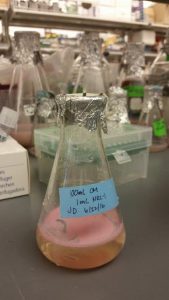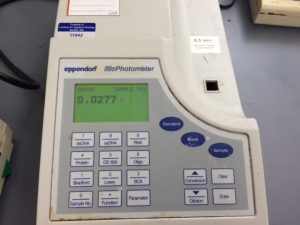Halobacterium salinarum
By Nida Khalil
What is Halobacterium salinarum?
Halobacterium salinarum is a type of archaea. It is rod-shaped and has mechanisms for movement such as gas vesicles and flagella. It grows fastest aerobically in amino acid-rich environments at moderate temperatures and nearly saturated brine. It is also a model organism because its gene regulatory networks and its genetic processing methods are similar to those of humans. A common strain of Halobacterium, the NRC-1 strain, has the ability to survive and grow phototrophically using the light driven proton pumping activity of bacteriorhodopsin in its purple membrane.
This graph demonstrates an optimal halobacteria growth curve at standard conditions which includes:
• 37°C
• shaking at 220 rpm
• full spectrum light
• complete media
What is Complete Media (CM)?
Complete Media is a combination of laboratory-grade chemicals and proteins that are necessary for the growth of halobacterium in a lab setting.
How to Make Complete Media
To make complete media, which is a 4.3 M salt and amino acid solution, add sodium chloride, magnesium sulfate, potassium chloride, sodium citrate and oxoid peptone to deionized water. Use a calibrated scale to measure proper masses and a stir plate with stir bar to thoroughly mix the solution. Autoclave all complete media prior to use.
Often when experimenting with Halobacterium we need to know its growth curve. To test the solutions and see if Halobacterium is growing in it we take the solution’s Optical Density (OD) using a spectrophotometer. A spectrophotometer is a device that uses a range of light waves to measure the absorbance of a solution. When in use, it emits a ray of light that either passes through the sample or is scattered and/or absorbed. This way we can determine if there has been a increase or decrease in Halo growth in the media, or if the population size has stayed constant.
 Left: In complete media halobacteria is pink in color.
Left: In complete media halobacteria is pink in color.
Above: Spectrophotometer.
During this internship, my lab partners Sumaiya Sathar, Sara Michelassi and I worked on two projects using Halobacterium as a model organism. The first of these two projects was testing the growth of NRC-1 in alternative forms of complete media. The second project we focused on was reviving and studying a mutation in a certain strain of Halo. To read more about the two projects, please click on the links below!
Identifying the Genetic Source if a Mutation in Halobacterium salinarum
Finding Low Cost Substitutes for Ingredients used in Complete Media for Halobacterium salinarum


